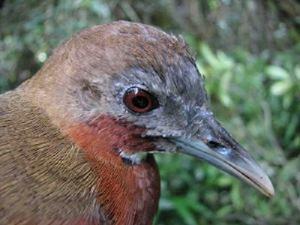Marc Rabenandrasana
The project aims to continue population census of Sakalava rail, conduct conservation action in order to protect its largest known breeding sites. And contribute in the taxonomy investigation of western forest wood rail occurring at Bemaraha Tsingy National Park.

Sakalava rail pair.
Conservation biology study and protection of Sakalava rail:

Forest grey fronted wood rail.
The Sakalava rail is an endangered wetland bird. This species has a fragmented geographical distribution and despite extensive surveys, is known to persist in only five sites in Western Madagascar: Kinkony, Mandrozo and lakes Ampandra, Amparihy and Sahapy (the Besalampy wetland complex). The Sakalava rail has very specific habitat requirements, needing undisturbed lakes with Phragmites reeds and floating Salvinia lilies. The breeding ecology and natural history of this species is practically unknown and we have no accurate population size estimate, although the Besalampy wetland complex appears to support about 70% of known individuals (Rabenandrasana et al 2009). This site is currently unprotected despite having been recently identified as meeting IBA criteria (Rabenandrasana 2007), and the site is threatened by human activities including wetland conversion to rice fields and an unmanaged freshwater fishery.
At Besalampy area, I will work with my technical assistant to collect baseline data need for Sakalava rail population breeding study. National population census using GIS habitat suitability remote sensing method is yet conducted in all known breeding sites including the Besalampy wetland complex, Kinkony (Mitsinjo) and Mandrozo (Tambohorano) lakes.
Public awareness will conduct surround the Besalampy project area by explaining to users the importance of wetland management, biodiversity conservation through organizing formal school and/or office visits. A specific event will also organize during market days.
Management plan documents for biodiversity conservation and fishery control will also prepare with help of Environment & Forest government responsible, this for later approval by all regional stakeholders involving in wetland uses.
Taxonomy study of western forest wood rail:
The Bemaraha rail is found in isolated dry forest habitat in the Bemaraha National Park (Langrand 1990, Ramanitra, 1993) but its taxonomic position still uncertain. It is considered conspecific with the wood rail Canirallus kioloides (Morris and Hawkins 1998) which is found in eastern rainforest habitats (ZICOMA 1999). However the Bemaraha rail differs in habitat type, plumage, bill morphology and is geographically isolated from the nominate species (Rabenandrasana and al in prep).
We will sample wood rails at Bemaraha Tsingy, then compare morphologic characters and their DNAs to other accessible rail population occurring in eastern rain forest sites such: Amber Mountain National Park in the north, Ranomafana national Park in the mid eastern and Tsitongambarika forest in the extreme south of Madagascar. Thus the Bemaraha wood rail might be a new species for science.